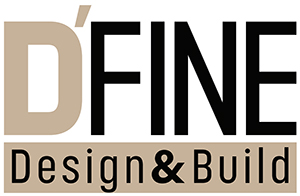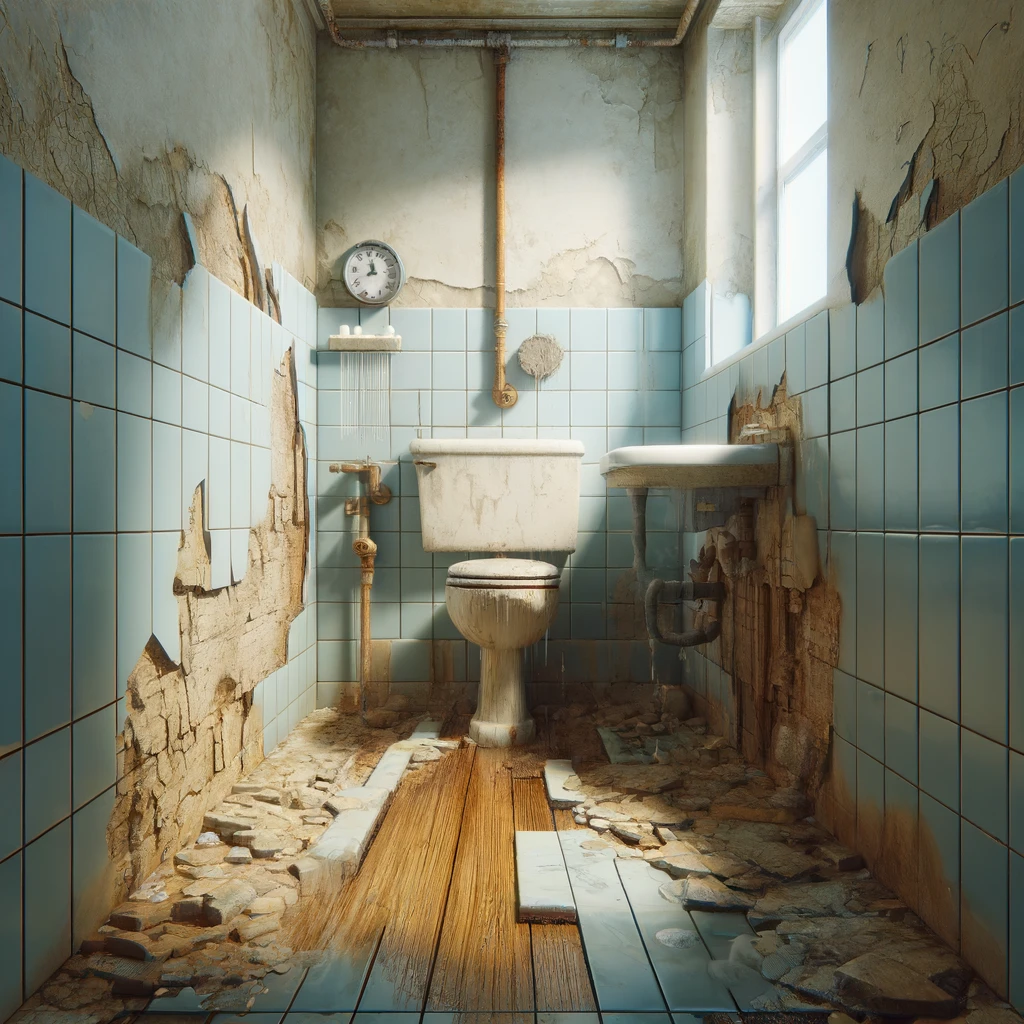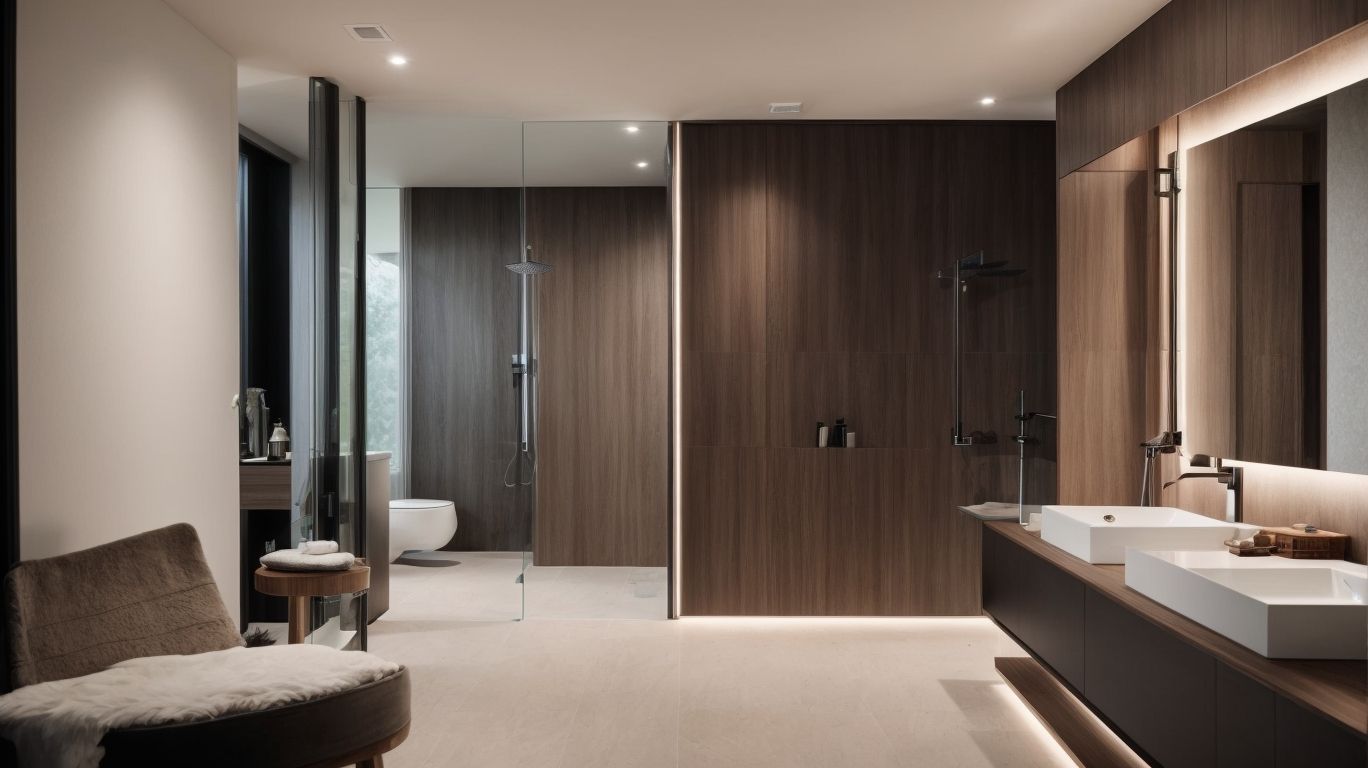Are you considering a bathroom remodel? Before you pick up that sledgehammer, it’s crucial to understand the potential pitfalls that can turn your dream renovation into a nightmare.
From poor planning and budget mismanagement to choosing the wrong fixtures and materials, there are numerous mistakes to avoid. In this article, we’ll explore the common slip-ups that homeowners make during bathroom remodeling and offer tips on how to navigate these challenges. Whether you’re a DIY enthusiast or hiring a professional, you’ll want to arm yourself with this essential knowledge before diving into your project.
Introduction to Bathroom Remodeling
Credits: Dfinedesignandbuild.Com – Matthew Allen
Bathroom remodeling is a significant undertaking that involves transforming the design, layout, and functionality of a bathroom space, incorporating essential elements such as plumbing, electrical work, fixtures, storage solutions, lighting, ventilation, and the selection of high-quality materials for a successful design-build project.
Optimizing the use of space is key in bathroom renovation, ensuring that every inch serves a purpose without compromising on aesthetics.
Design plays a crucial role in creating a harmonious and practical layout, from the arrangement of fixtures to the choice of color schemes and materials.
The integration of modern technology, such as smart appliances and energy-efficient solutions, adds a contemporary touch while enhancing the overall functionality.
Failing to Plan Ahead
One of the most common mistakes in bathroom renovation is failing to plan ahead, which can lead to budget overruns, design complications, and logistical challenges during the remodeling process.
Proper planning is crucial to the success of a bathroom renovation project. It allows homeowners to anticipate any hurdles that may arise, such as structural issues, plumbing complications, or unexpected expenses.
With comprehensive planning, budget management becomes more efficient, ensuring that funds are allocated appropriately for materials, labor, and potential unforeseen costs. Having a well-thought-out plan helps in avoiding last-minute design changes, reduces disruptions during the construction phase, and ultimately leads to a more satisfying and successful remodeling experience.
Not Visualizing the Design
Visualizing the design is a crucial aspect of bathroom remodeling, as it allows homeowners and designers to envision the placement of fixtures, accessories, and layout elements within the space, ensuring a cohesive and functional design outcome.
Design visualization plays a fundamental role in guiding fixture selection. It enables individuals to assess how different fixtures and fittings contribute to the overall aesthetic of the bathroom. By virtually laying out the fixtures, such as the vanity, shower, and toilet, through visual tools, homeowners get a good idea of the spatial requirements and how each element interacts within the room.
Managing the Budget
Effective budget management is essential for the success of a bathroom renovation project, encompassing careful allocation of resources for fixtures, materials, and design-build elements to achieve the desired outcome within financial constraints.
When considering fixture choices, cost-effective options, such as water-efficient faucets and LED lighting, can aid in reducing long-term operational costs.
Selecting durable yet affordable materials, such as porcelain tiles and acrylic bathtubs, contributes to maintaining the project’s budget.
Embracing design-build principles, like open shelving and multipurpose storage solutions, not only adds aesthetic value but also optimizes space efficiency, further aligning with prudent budget planning.
Choosing the Right Fixtures and Materials
Selecting the right fixtures and materials is a critical decision in bathroom remodeling, influencing the functionality, aesthetic appeal, and durability of the space, encompassing elements such as plumbing, electrical requirements, and design considerations.
When choosing fixtures, it’s essential to consider the water efficiency, ease of cleaning, and the overall design harmony with the rest of the bathroom.
The selection of materials plays a pivotal role in determining the longevity of the remodeled space and its ability to withstand moisture, daily usage, and cleaning products. For instance, quality tiles not only enhance the visual appeal but also contribute to the waterproofing and ease of maintenance.
Considering Layout Changes
Evaluating and considering layout changes is a crucial component of bathroom remodeling, addressing spatial optimization, design enhancements, and the integration of plumbing and electrical modifications to achieve an efficient and aesthetically pleasing layout.
A well-thought-out layout can drastically improve the functionality and visual appeal of a bathroom. Space utilization is key, and incorporating measures such as repositioning fixtures, creating storage solutions, and maximizing natural light can make a significant difference.
Moreover, design improvements can elevate the overall ambiance, whether it’s through modernizing the aesthetic or introducing a more efficient flow within the space.
When considering layout changes, it’s essential to also evaluate the impact on plumbing and electrical requirements. Alterations to the layout may necessitate adjustments to the existing infrastructure, so understanding these implications is crucial for a successful renovation.
Additionally, optimizing the spatial arrangement can contribute to a more sustainable and energy-efficient design, which is increasingly important in modern remodels.
Evaluating Skillset and DIY Options
Assessing one’s skillset and considering DIY options is an important decision in bathroom remodeling, as it determines the feasibility of handling aspects such as plumbing, electrical work, and minor construction tasks independently or with professional assistance.
DIY enthusiasts often value the opportunity to demonstrate their abilities while saving on labor costs. However, it’s crucial to recognize the complexity of electrical work and plumbing and understand the potential risks involved.
Skill assessment helps in evaluating whether one has the necessary expertise to execute these tasks or if it’s safer to rely on skilled professionals. By gauging one’s capabilities, individuals can minimize the probability of costly mistakes and ensure their bathroom remodeling project progresses smoothly.
Proper Floor and Wall Tiling
Ensuring proper floor and wall tiling is essential in bathroom remodeling, as it contributes to the overall aesthetic, functionality, and waterproofing of the space, requiring careful attention to material selection and design integration.
Tiling materials play a pivotal role in determining the durability and visual appeal of bathroom tiles. Options like ceramic, porcelain, natural stone, and glass offer diverse characteristics.
Ceramic tiles are versatile and cost-effective, while porcelain provides exceptional moisture resistance. Natural stone creates a luxurious ambiance, and glass tiles add a modern touch. The installation techniques must be precise to ensure a cohesive and watertight finish.
Design considerations, such as color, pattern, and layout, can elevate the aesthetic and create a cohesive tiling solution.
Understanding Faucet and Countertop Placement
Understanding faucet and countertop placement is a crucial aspect of bathroom remodeling, influencing both the functional utility and aesthetic appeal of the space, requiring careful consideration of plumbing requirements and design coherence.
The positioning of faucets and countertops not only affects the overall look and feel of the bathroom but also plays a significant role in optimizing the functionality of the space.
Proper placement can enhance the user experience and contribute to a harmonious design. It impacts plumbing configurations as well, determining the layout and installation of fixtures.
The thoughtful alignment of faucets and countertops ensures convenience and accessibility, which are vital for creating a practical and enjoyable bathroom environment.
Optimizing Shower System and Flooring
Optimizing the shower system and flooring is critical in bathroom remodeling, encompassing the selection of water-resistant materials, efficient drainage solutions, and cohesive design integration to create a functional and visually appealing bathing space.
When considering the shower system, it’s essential to choose materials that can withstand prolonged exposure to moisture and frequent use.
Ceramic tiles, porcelain tiles, and natural stone are popular choices for shower walls and floors due to their water-resistant properties and durability.
Proper drainage is crucial to prevent water accumulation and potential damage, so installing a sloped floor and high-quality drainage system is imperative.
Importance of Proper Ventilation
Proper ventilation is a crucial consideration in bathroom remodeling, contributing to air quality, moisture control, and the overall comfort and longevity of the space, requiring thoughtful integration within the design and spatial layout.
Incorporating an efficient ventilation system is essential to minimize mold, mildew, and humidity buildup, which can lead to structural damage and health issues. By strategically placing exhaust fans, windows, or skylights, the moisture management can be effectively handled, creating a healthier environment.
The design considerations play a pivotal role in seamlessly integrating ventilation solutions without compromising the aesthetic appeal of the bathroom.
Utilizing Natural Stone and Paint Correctly
The correct utilization of natural stone and paint is essential in bathroom remodeling, as it contributes to the aesthetic richness, durability, and visual cohesion of the space, requiring mindful selection and design harmonization.
In terms of material selection, natural stone offers a timeless elegance, with options such as marble, granite, and limestone. These materials not only enhance the visual appeal of the bathroom but also provide immense durability, standing the test of time in a high-moisture environment.
Additionally, paint plays a crucial role in tying the entire design together. Choosing the right color palette and application technique can transform the space, creating a harmonious and inviting ambiance.
It’s essential to consider the overall design coherence. Pairing the natural stone with complementary paint colors and fixtures can elevate the aesthetics of the bathroom, creating a visually striking interior. The correct application of natural stone and paint is not just about individual elements; it’s about creating a cohesive design that exudes sophistication and practicality.
Organizational and Electrical Considerations
Addressing organizational and electrical considerations is integral to successful bathroom remodeling, encompassing efficient storage solutions, adequate lighting arrangements, and seamless integration within the overall design for functional and visually appealing outcomes.
Efficient storage solutions are essential in a bathroom to maintain a clutter-free and organized space. Incorporating built-in shelving, vanity cabinets, and concealed storage units maximizes space utilization and enhances the aesthetic appeal.
Lighting arrangements play a crucial role in creating a well-lit and inviting atmosphere in the bathroom. Proper lighting not only ensures functionality but also contributes to the overall ambiance.
Seamless integration within the overall design ensures that the organizational and electrical elements blend harmoniously with the aesthetic vision, resulting in a cohesive and appealing bathroom remodel.
Procurement of Materials
The procurement of materials is a critical stage in bathroom remodeling, involving the acquisition of fixtures, fittings, and construction elements, highlighting the importance of quality, compatibility, and design alignment within the project scope.
When considering fixture selection, it’s essential to prioritize functionality and style, ensuring that the chosen fixtures complement the overall design aesthetic.
A careful evaluation of material quality is crucial, as durable materials such as porcelain, marble, and ceramic can enhance the longevity and visual appeal of the space.
Design compatibility plays a significant role in creating a cohesive and harmonious bathroom environment. Integrating materials that seamlessly blend with the existing decor and architectural elements is vital for achieving a polished and unified look.
Procuring materials involves a meticulous assessment of suppliers, comparing prices, lead times, and ecofriendly options, ensuring that the selected materials align with the project’s sustainability goals.
Common Mistakes to Avoid in Bathroom Remodeling
Avoiding common mistakes in bathroom remodeling is crucial for project success, encompassing aspects such as design errors, fixture misplacements, and inadequate planning, highlighting the need for well-considered choices throughout the renovating process.
One significant design error to avoid is inefficient layout planning, which can result in cramped spaces or awkward traffic flow.
Another common mistake is the improper placement of fixtures, such as poorly positioned showerheads or improperly installed toilets, which can affect functionality and aesthetics.
Inadequate planning, including overlooking essential utilities or underestimating project costs, can lead to delays and budget overruns.
Therefore, thorough project planning and attention to detail are imperative for a successful bathroom renovation.
Conclusion and Final Tips
Successful bathroom remodeling requires meticulous planning, thoughtful design choices, and skilled execution to transform the space into a functional and aesthetically pleasing sanctuary.
For optimal outcomes, professional assistance can provide valuable insights and ensure that the project adheres to regulatory requirements and best practices.
It’s essential to prioritize quality fixtures and materials to ensure durability and enhance the overall appeal of the renovated space.
Strategic design optimization can maximize the functionality of the bathroom while creating a visually inviting environment.
By paying attention to these key aspects, homeowners can achieve a successful and satisfying bathroom renovation that adds value to their property and enhances their daily living experience.
Frequently Asked Questions
What are the common mistakes to avoid when remodeling a bathroom?
When remodeling a bathroom, it’s important to avoid making mistakes that can lead to costly repairs and delays. Some common mistakes to avoid include not properly waterproofing the shower or tub, using incorrect materials, and not hiring a licensed and experienced contractor.
Is it necessary to have a detailed plan before starting a bathroom remodel?
Yes, it is crucial to have a detailed plan before starting a bathroom remodel. This will help ensure that the project stays within budget and on schedule. It will also prevent any unnecessary changes or delays during the remodeling process.
What are some important factors to consider when choosing materials for a bathroom remodel?
When choosing materials for a bathroom remodel, it’s important to consider durability, water resistance, and maintenance requirements. You should also consider the overall aesthetic and choose materials that will complement each other and create a cohesive look.
How can I make sure my bathroom remodel is a resilient and long-lasting investment?
To ensure your bathroom remodel is a resilient and long-lasting investment, it’s important to use high-quality materials, hire a reputable contractor, and prioritize proper installation and waterproofing. Regular maintenance and addressing any issues promptly can also help prolong the life of your remodel.
What are the benefits of hiring a professional contractor for a bathroom remodel?
Hiring a professional contractor for a bathroom remodel can provide multiple benefits, including their expertise and experience, access to high-quality materials, proper project management, and the assurance of a warranty or guarantee. They can also help you avoid costly mistakes and ensure a successful and efficient remodel.
What are some signs that indicate a need for a bathroom remodel?
Some signs that indicate a need for a bathroom remodel include outdated or worn-out fixtures, water damage or mold, lack of functionality or storage space, and a general desire for a more modern and updated space. It’s also a good idea to consider a remodel if you plan on selling your home in the near future.
Timonium, MD Showroom
Location
D’Fine Design and Build
2135 York Rd, Suite C
Timonium, MD 21093
Opening Hours
Monday to Friday: 9am – 5pm
Saturday: 10am – 5pm
Sunday: Closed
Sales & Order Enquiries
(410) 616-9949
[email protected]


